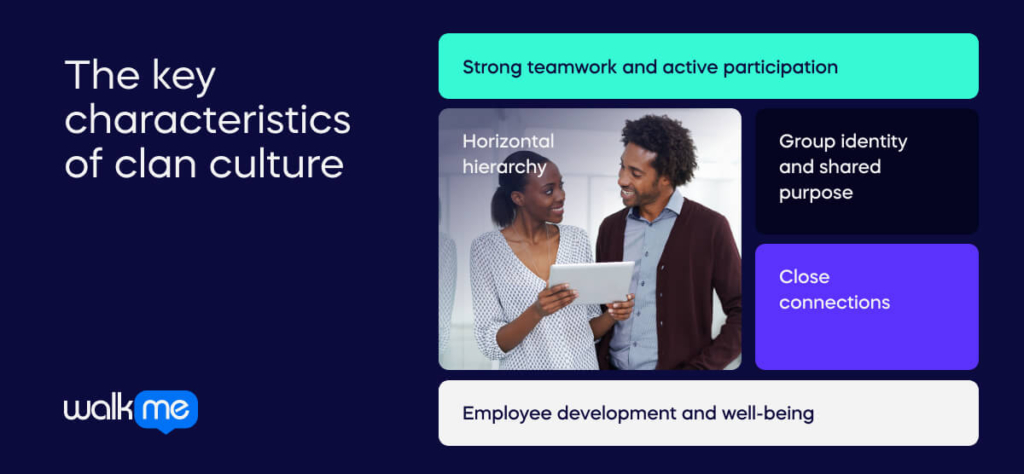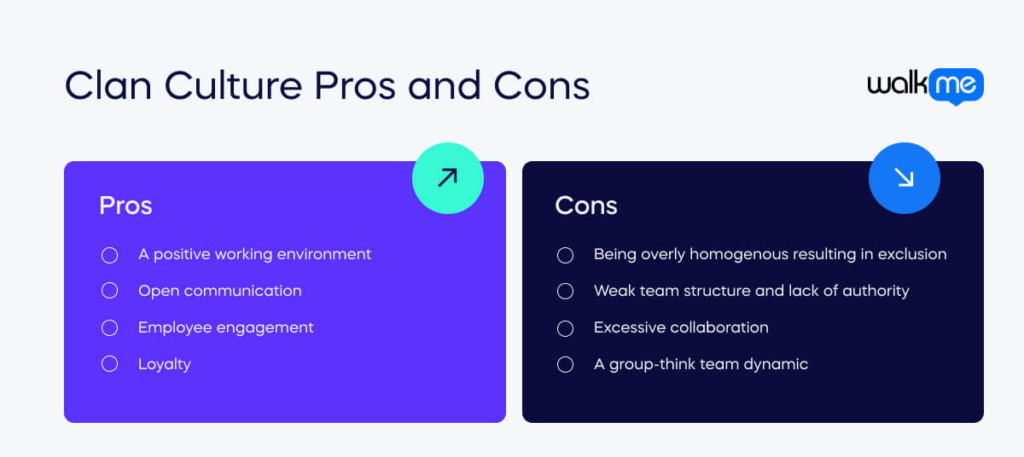How does your clan operate?
It is likely a clan culture if your organizational culture cultivates a familial atmosphere while prioritizing loyalty, engagement, and collaboration. Other cultures you may identify when looking at your own might be hierarchy culture, market culture, or adhocracy culture.
Its flat hierarchy helps teams become inseparably tight-knit. These teams embody the organization’s vision and mission, and C-suites can always depend on them for positive project outcomes.
One 2024 academic study found a close relationship between clan culture and organizational performance. This relationship between this culture and higher performance establishes clan culture as a viable culture for 2024 to gain the edge over competitors for higher revenue and employee retention.
So, jump into this comprehensive guide on clan culture. We will examine clan culture, its key characteristics, advantages and disadvantages, examples, and how to promote it from your HR department. Let’s begin with a definition.
What is clan culture?
Clan culture in business cultivates a familial atmosphere. It prioritizes loyalty, employee experience, engagement, and collaboration. Its flat hierarchy nurtures tight-knit teams bonded by a common purpose. These teams embody the organization’s vision and mission.
“Clan culture” parallels traditional kinship groups. In these groups, individuals bond over shared ancestry. In this organizational setting, management prioritizes flexibility over rigid control. Rules are enforced socially rather than through formal procedures, so each individual follows them without leaders enforcing them.
What are the key characteristics of clan culture?

Clan culture has several distinctive characteristics, each contributing to its cohesive and nurturing environment. The first is strong teamwork, which promotes active participation from every group member.
Strong teamwork and active participation
Active participation and robust teamwork form the cornerstone of clan culture. Collaboration and trust drive individuals to engage beyond their job descriptions.
Employees actively contribute ideas and perspectives, leveraging collective wisdom to tackle challenges and innovate solutions. Bonds among colleagues are solid, fostering a collective ethos that propels the team towards shared objectives.
Horizontal hierarchy
Informality and a horizontal organizational structure define clan culture. Hierarchical barriers are minimal, promoting an inclusive environment where management assumes a nurturing role akin to family leadership.
Roles may lack formal delineation, allowing employees to undertake diverse responsibilities within the fluid structure.
Group identity and shared purpose
A profound sense of group identity permeates clan culture, anchoring individuals within a larger purpose beyond themselves.
Employees forge strong emotional ties to the organization’s mission, values, and their peers, fostering a culture of camaraderie and loyalty.
There is an implicit allegiance to the company and a competitive spirit towards rival entities.
Close connections
Tight-knit connections characterize interactions within clan culture. Colleagues operate as a cohesive unit, prioritizing internal cohesion over external affiliations.
The integration of new hires often occurs through referrals, cementing existing bonds, and perpetuating the culture of collaboration. Social interactions extend beyond work hours, reinforcing camaraderie and facilitating informal mentoring among peers.
Employee development and well-being
Clan culture underscores a commitment to employee well-being and growth. It fosters a supportive environment where mentorship flourishes, enabling individuals to learn from one another and develop professionally.
Emphasis is placed on creating a safe and pleasant workplace, ensuring employees have the resources and support needed to thrive and contribute meaningfully to the collective endeavor.
Clan culture epitomizes an organization’s familial ethos, fostering collaboration, camaraderie, and mutual support among its members. This culture nurtures a sense of belonging, promotes active participation, and prioritizes its employees’ holistic well-being and development.

What are the advantages of clan culture?
The tribal essence of clan culture and reduced internal competition prove highly effective for specific organizations. There are many benefits to this type of culture. Consider the benefits below to help you decide to transform your organization using a clan culture.
The strengths of clan culture can breed the following benefits:
A positive working environment
Prioritizing employee well-being and satisfaction fosters a sense of belonging and appreciation.
This environment uplifts morale and motivation and cultivates a positive work environment. Employees, united by common values, forge a familial atmosphere akin to an all-star team, enhancing workplace satisfaction for many.
Open communication
In clan culture, akin to family gatherings, routine check-ins are customary.
These include one-on-one sessions, employee surveys, and open forums, ensuring everyone feels heard and informed.
Embracing ideas and honest feedback facilitates swift resolution of issues through collective effort. Openness and transparency foster trust between managers and colleagues, curbing gossip and complaints within the workplace.
Employee engagement
Employees seek fulfillment beyond monetary compensation, desiring alignment with their employer’s mission.
Pride in belonging fosters camaraderie and alignment with company values. Engaged employees exhibit heightened dedication, surpassing minimal expectations and channeling extra energy into their work.
Consequently, their enthusiasm translates into exceptional performance and innovative customer solutions, enhancing overall satisfaction and success.
Loyalty
A familial, collaborative culture instills deep allegiance, fostering employee dedication to colleagues and company success.
Such loyalty ensures employees remain committed, contributing to the organization’s prosperity.
Satisfied and secure, they are less inclined to seek alternative employment opportunities, bolstering retention rates.
What are the disadvantages of clan culture?
Although a clan-like environment can be a very effective company culture, it does have its drawbacks. It is essential to consider these disadvantages before committing to this culture for your organization.
Potential disadvantages of clan culture can include the following:
Being overly homogenous resulting in exclusion
Clan culture organizations are often insular. They are reluctant to embrace external ideas that could help them grow. Relying on referrals for hiring may lead to a lack of diversity within the workforce.
New employees lack connections. They may struggle to join tight teams. This approach fosters feelings of exclusion. It can be hard to join a clan. This difficulty can cause fights.
Weak team structure and lack of authority
Ambiguity in the chain of command poses challenges for effective decision-making. In strictly top-down management structures, mid-level leaders may lack clarity on when to exercise their judgment in urgent matters.
Successful mentoring and rapport between management and staff rely on well-defined boundaries. Blurred lines hinder the imposition of authority.
Employees lacking loyalty to the company might exploit flexible policies to evade undesirable tasks. Moreover, an informal atmosphere can devolve from harmless banter to hurtful behaviors when boundaries are unclear.
Clarifying roles and expectations is crucial for fostering a healthy work environment and ensuring that communication channels remain respectful and productive.
Excessive collaboration
While beneficial in theory, promoting transparent communication and participatory decision-making can inadvertently lead to a proliferation of meetings and prolonged decision-making processes.
Thus, we must balance inclusivity and efficiency. It is paramount. This ensures diverse views are valued. But it still allows for timely and decisive action when needed.
A group-think team dynamic
People with shared values and demographics often have similar opinions. They might have shared biases.
Similar views deprive organizations of the benefits of diverse viewpoints.
Also, in tight-knit groups, people may feel forced to conform. This approach stifles dissent and hinders innovation. Reluctance to express other views hurts. It stops the influx of fresh ideas. These ideas are critical for progress in organizations.
What are some examples of clan culture?
Understanding the concept and traits of clan culture is essential, but practical examples illustrate how you might be able to apply it in your organization. Explore these enterprise instances of clan culture.
Also, note the accompanying insights explaining their significance and helping you optimize your clan culture.
Zappos
Zappos, an e-commerce giant specializing in footwear and apparel, is celebrated for its dynamic clan culture.
Embracing a familial ambiance, Zappos prioritizes core values like “Deliver WOW Through Service” and “Create Fun and A Little Weirdness.” The company champions open dialogue and empowers employees, promoting individual expression.
It is dedicated to fostering a positive workplace. This is clear in initiatives like the “Culture Book.” Staff contribute insights into company culture in it. This strengthens a sense of belonging.
What can we learn from this example?
Zappos’ clan culture teaches us the power of fostering camaraderie and innovation through core values like “Deliver WOW Through Service” and “Create Fun and A Little Weirdness,” emphasizing employee empowerment and a positive work environment.
Google is a renowned technology powerhouse. It thrives on a clan culture. This culture promotes creativity, collaboration, and community spirit.
Aligned with its mission to “organize the world’s information and make it universally accessible and useful,” Google nurtures an inclusive and innovative workplace.
Google offers perks. These include flexible schedules, wellness programs, and creative hubs. The company prioritizes employee well-being.
Clear communication shows employees are valued. It creates a clan culture that fosters personal growth and organizational success.
What can we learn from this example?
From Google’s clan culture, we learn the importance of fostering creativity, collaboration, and community spirit through values like “Organize the world’s information.” This emphasizes employee empowerment, innovation, and a supportive work environment.
Southwest Airlines
Southwest Airlines stands out in the aviation sector for its distinct clan culture. Upholding values like “Warrior Spirit,” “Servant’s Heart,” and “Fun-LUVing Attitude,” Southwest cultivates camaraderie and unity among its workforce.
Prioritizing employee welfare, the company provides benefits like profit-sharing, employee stock ownership, and pathways for career growth.
This commitment to fostering a positive and empowering workplace has bolstered Southwest’s reputation for outstanding customer service and operational prowess.
What can we learn from this example?
Southwest Airlines teaches us the significance of cultivating collaboration and shared purpose through values like “Warrior Spirit” and “Fun-LUVing Attitude.” This philosophy underscores the importance of employee well-being, teamwork, and exceptional service delivery.
How can your HR team promote clan culture?
Creating a fitting company culture can yield good business results. Clan culture emphasizes teamwork, collaboration, and belonging. It could advantageously influence your organization’s teams.
Consider ways to grow these clan culture traits. They will reshape your company’s ethos.
Build trust
A positive work environment hinges on cultivating trust among team members and between employees and managers.
Here are the approaches to foster this trust:
Encourage managers to form real connections. They should do this with their teams. They should care about their work and personal lives. This will help them build rapport. They should prioritize making new hires feel welcome. They should ensure the hires integrate smoothly into the team.
Create chances for executives to talk to employees. They can do this by attending team meetings or mingling in informal settings. This visibility humanizes leadership, making them more approachable and relatable.
We should celebrate successes. And see failures as learning chances, not for blame. Leaders should openly discuss failed decisions. They should use them as lessons for improvement. We should recognize people who excel. They exceed expectations and build a culture of appreciation and motivation.
Introduce shared team rewards
While individual rewards motivate employees and boost morale and loyalty, shared team rewards can promote employee synergy for better teamwork.
Examples of this type of incentive include team performance-based bonuses, prizes, and annual recognition events.
The target performance or output must depend on everyone’s contributions for these to be effective. Also, leaders must base performance criteria for the rewards on clear, impartial standards.
Promote a feedback culture
Promoting openness, feedback, and idea-sharing aligns with clan culture principles. This approach feeds into many other aspects of clan culture, such as open communication and collaboration.
Consider these strategies to promote a feedback culture:
- Facilitate brainstorming sessions to encourage idea generation.
- Invite input on proposals and initiatives from team members.
- Encourage managers to practice active listening and value employee perspectives.
- Act on feedback promptly and communicate decisions or changes made.
Offer various feedback channels to accommodate diverse communication preferences. Ensure employees feel safe expressing their views without fear of negative consequences, fostering an environment of honesty and openness conducive to collaboration and innovation.
Spark connections among employees
Enhancing coworker connections fosters improved collaboration. This environment can lead to better project outcomes and lower turnover. Consider these employee bonding initiatives:
- Micro-mentoring initiatives.
- Special project teams.
- Structured team-building activities.
- Team game competitions.
- Informal lunch outings are devoid of work discussions.
- Group volunteer activities for charitable causes.
Strengthen the sense of belonging
Understanding the organization’s mission and role fosters employee connection and a sense of belonging. Aligning employees with the organizational purpose is crucial.
In addition to valuing and acting on feedback, managers must ensure inclusivity by actively seeking input from all employees, including those who typically remain silent. Creating specific opportunities for idea-sharing is essential.
Extending a sense of belonging to gig and remote workers is equally vital. Encourage participation in team or company events whenever feasible, ensuring they feel valued and integrated into the organizational culture.
Research clan culture before implementing it
Clan culture has many benefits. It brings open communication and a positive work environment. However, it can also result in disadvantages, such as homogenous teams and weak team structures.
You must thoroughly research how clan culture might work in your organization. This step is essential before incorporating it.
Understand its key traits, which include teamwork, collaboration, and a family-like atmosphere. Explore successful case studies, noting implementation strategies and potential challenges similar organizations face.
Consider whether clans fit your company’s values, goals, and culture. Assess your leadership team and employees for the transition. Ensure they are aligned and committed at all levels.
In the end, informed decision-making is key. It should be based on thorough research. This will maximize the benefits and minimize the downsides of clan culture integration.

FAQs
While clan culture fosters consensus, in large organizations, this can slow decision-making due to the need for widespread agreement, potentially hindering responsiveness to market changes.
As organizations grow, maintaining the close-knit, family-like atmosphere of clan culture becomes challenging, potentially leading to diluted values and decreased employee engagement.
Integrating stringent compliance measures may conflict with the flexible, informal nature of clan culture, requiring careful balancing to maintain cultural integrity while ensuring regulatory adherence.
Clan culture’s emphasis on collaboration and open communication can foster innovation by encouraging idea-sharing, but may also lead to groupthink, limiting diverse perspectives.
Transitioning may be appropriate when organizational goals shift towards competitiveness and efficiency, necessitating a culture that supports rapid decision-making and performance metrics over consensus and cohesion.

